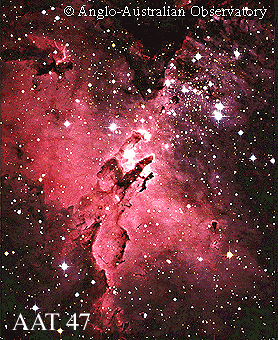Credit & Copyright: Anglo-Australian Telescope
Board
Explanation:
The photogenic
M16 shown above is composed of a
young star cluster and a
spectacular emission nebulae
lined with distinct regions of
interstellar dust.
Most of the stars in the
cluster
can be seen offset just above and to the right of the photograph's center.
This type of star cluster is called an "open" or "galactic" cluster and
typically has a few hundred young bright members. The redness of the
surrounding
emission nebula gas is caused by
electrons recombining with hydrogen nuclei, while the dark regions are
dust lanes that absorb much of
the radiation that enters it. The dust absorbs so much light it allows
astronomers to determine which stars are inside the nebula and which are in
the foreground.
1999 2000 2001 2002 2003 2004 2005 2006 2007 2008 2009 2010 2011 2012 2013 2014 2015 2016 2017 2018 2019 2020 2021 2022 2023 2024 2025 |
Yanvar' Fevral' Mart Aprel' Mai Iyun' Iyul' Avgust Sentyabr' Oktyabr' Noyabr' Dekabr' |
NASA Web Site Statements, Warnings, and Disclaimers
NASA Official: Jay Norris. Specific rights apply.
A service of: LHEA at NASA / GSFC
& Michigan Tech. U.
|
Publikacii s klyuchevymi slovami:
dust - M 16 - open cluster - Rasseyannoe skoplenie - emissionnaya tumannost' - Mezhzvezdnaya pyl'
Publikacii so slovami: dust - M 16 - open cluster - Rasseyannoe skoplenie - emissionnaya tumannost' - Mezhzvezdnaya pyl' | |
Sm. takzhe:
Vse publikacii na tu zhe temu >> | |
